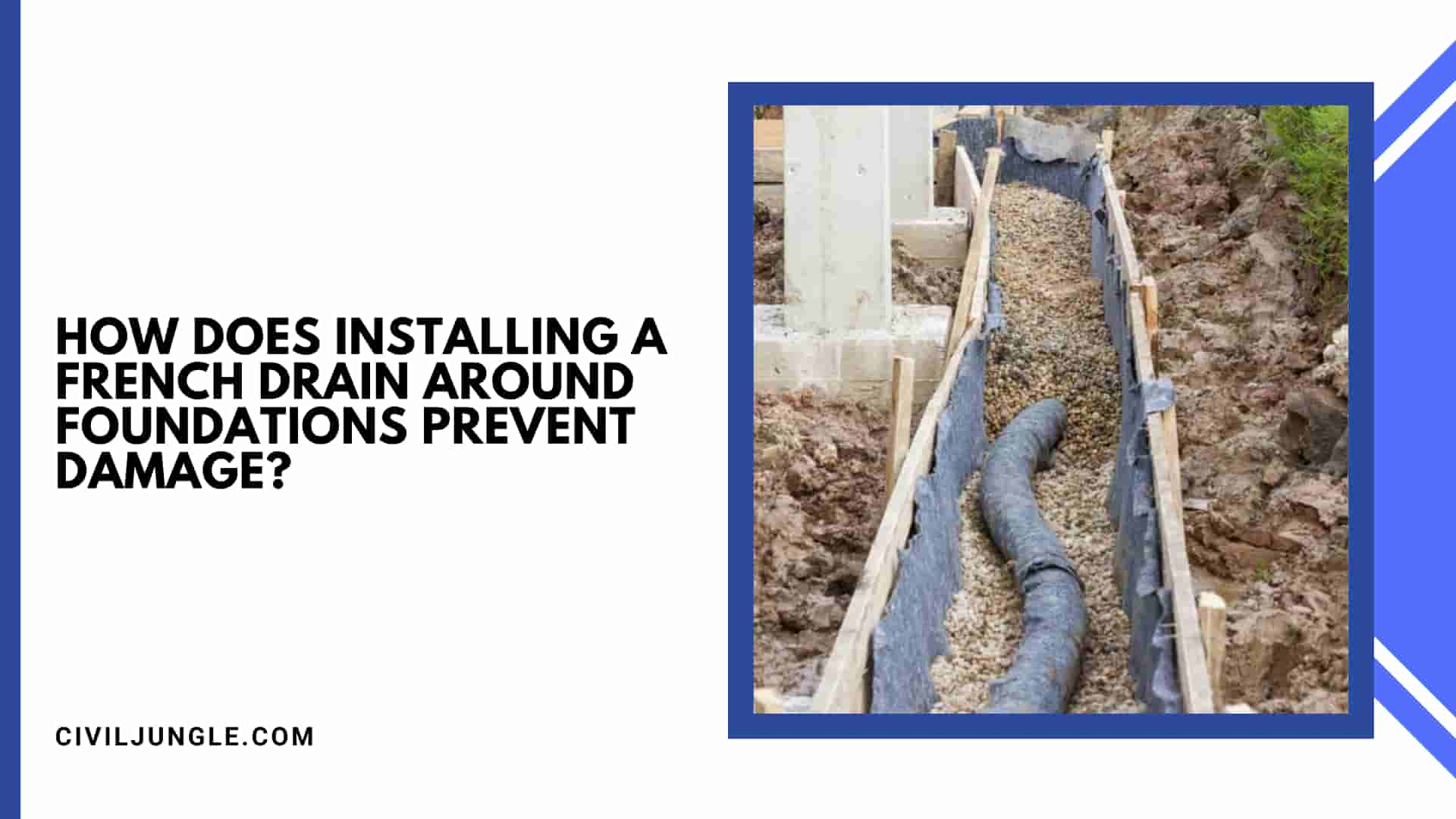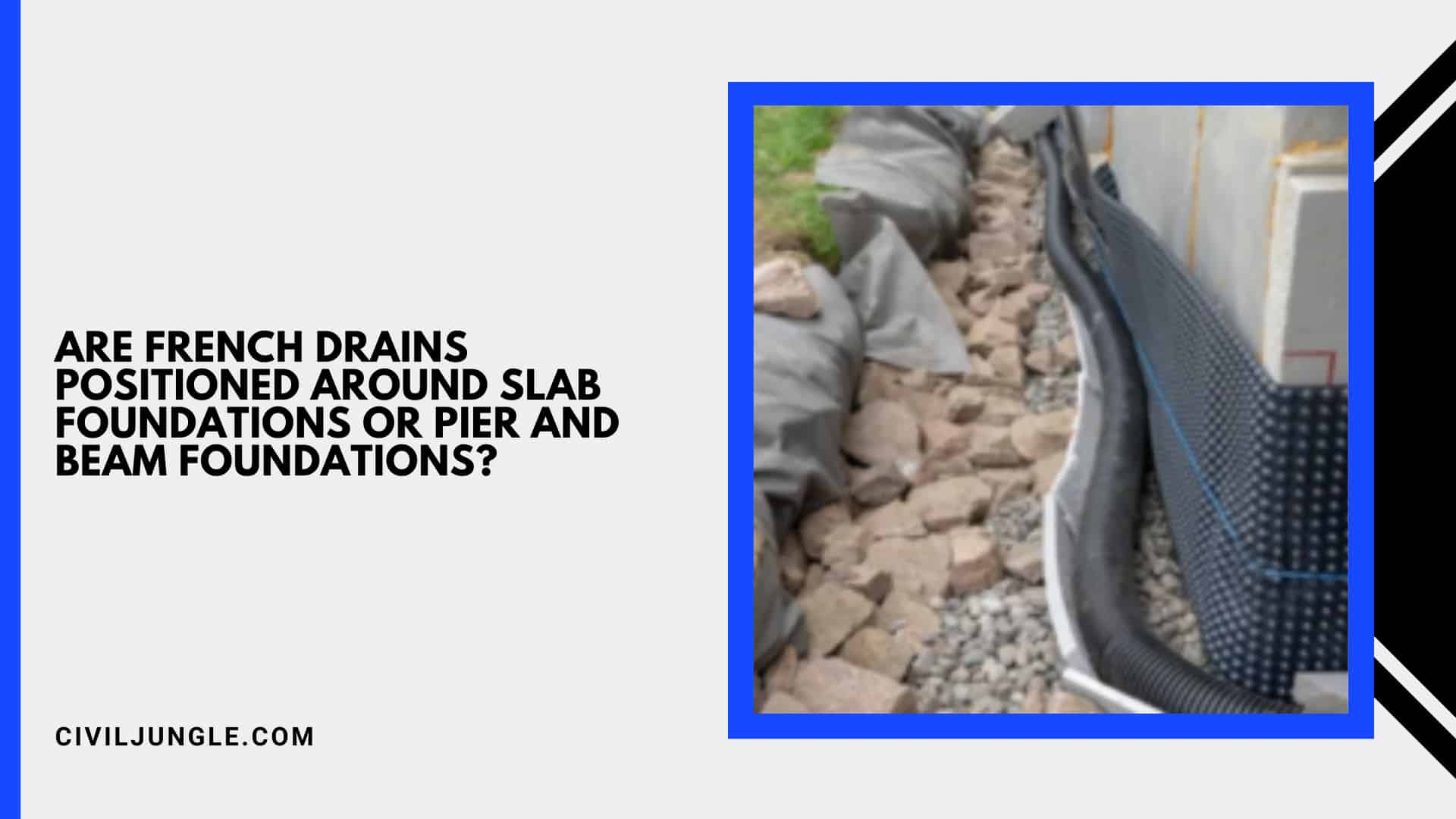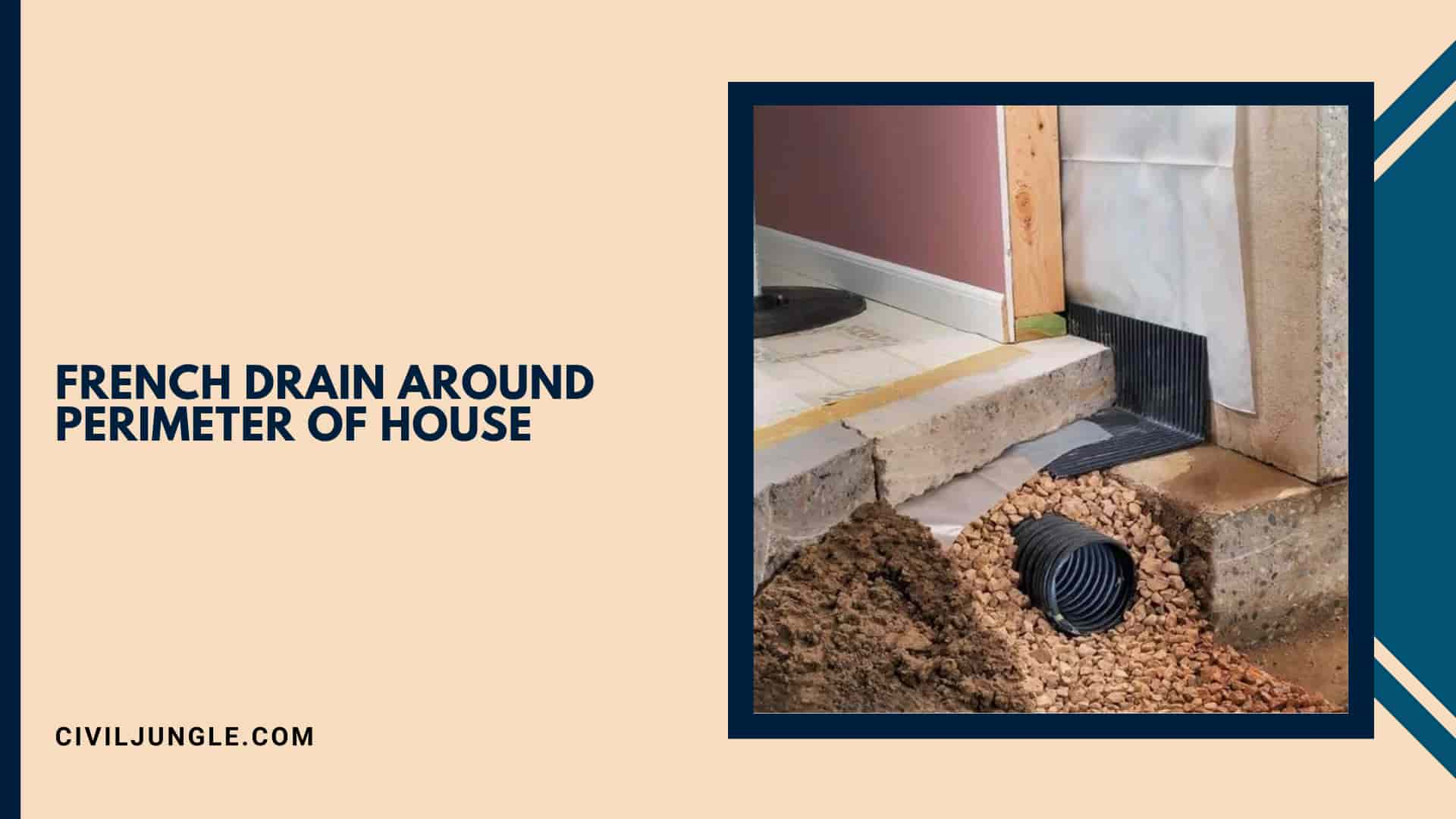How Does Installing a French Drain Around Foundations Prevent Damage?
Important Point
When installed in the Dallas-Fort Worth area, they eliminate foundation problems by re-directing any water away from the foundation. They’re widely used in the metroplex since they’re so good at preventing the need for foundation maintenance.
A French drain is particularly popular in North Texas because it eliminates foundation problems by diverting moisture away from the structure.
These drains, which are wrapped in a specific landscape fabric or plastic, come in a variety of sizes and shapes, but they are essentially ditches with pipes with small perforations.
The trenches are typically 12 inches wide, with gravel or another sort of rock covering the drains within them.
Water can flow through the pebbles on top of your French drain, down into the drain, and away from your foundation because of the system’s design. This prevents water damage to your foundation.
Water concerns are efficiently solved with French drains, which transfer water a safe distance away from your home’s foundation. As a result, foundation work is not necessary. The drain should slope no less than 1 inch for every 8=10 feet of length and exit in a ditch, roadway, or other safe location.
When it comes to water issues, French drains are frequently a fantastic answer. Surface drains are, of course, more suited in some situations.
By eliminating the risk of foundation cracks, a moist crawl space beneath your pier and beam foundation, or mold and mildew, these technologies efficiently minimize issues impacting your foundation and prevent the need for foundation repair.
Water causes a slew of drainage issues, but drainage solutions like French drains help to prevent foundation damage. You may be able to prevent having to fix your foundation by lowering the amount of dampness that surrounds it.
Are French Drains Positioned Around Slab Foundations or Pier and Beam Foundations?
Around both types of foundations, French drains are placed. They’re made by excavating a trench around your foundation, a whole or portion of it.
The trench is then lined with a drainage pipe. This drain, when placed around a concrete slab foundation, aids in the prevention of slab foundation cracks.
Keep in mind that water can exert hydrostatic pressure on a slab foundation when it travels beneath it. A homeowner can reduce the chances of this happening by installing a French drain.
Installing a French drain around the slab will also help to prevent heaving because water can force a slab foundation upward. French drains are utilized to prevent water damage in and around crawl areas when pier and beam foundations are used.
Pooled water may destroy wood, produce mold, and create a slew of other dangerous situations. Moisture trapped in a crawl area can affect a home’s floorboards, causing them to sag and squeak.
High humidity levels in crawl spaces should be avoided at all costs. Take the necessary actions to protect your home and avoid harm.
French Drain Around Perimeter of House
A French drain around the perimeter of your home would be a fantastic, low-cost option to redirect water runoff without having to completely regrade the yard. A French drain is an underground “gutter” system that gathers and drains water before it reaches the foundation of your home.
Digging a 12” to 18” deep trench that slopes downward to direct water away from the home is the first step in constructing a French drain.
The canal is then filled with gravel and corrugated plastic pipe is placed in it. Water is sluggish, so it will fall into your channels and be redirected before it reaches your foundation.
Heavy digging, as well as carrying and shoveling gravel, will be required for a French drain. It also needs forethought, since the channels must slope appropriately or water would accumulate in them and not drain off.
After you’ve designed your design, you may recruit the assistance of friends, family, or even paid laborers to help with the physical job.
You may also hire a certified landscaping contractor to construct the French drain for you, which would be considerably less expensive than regarding the entire yard or constructing retaining walls.
Aside from the French drain, make sure that any rainfall from your roof is diverted away from your home’s foundation — you’d be amazed how much water can be eliminated this way. If you have gutters, make sure the downspouts are pointing away from the foundation or toward the French Drain.
Also Read: What Is Raft Foundation | Types of Foundation | Detail of Raft Footing
Installing French Drain in Crawl Space
Signs You Need Crawl Space Drainage
Standing Ground Water: If you have standing water or a muddy crawl space floor, this is the clearest indicator that you require crawl space repair. Flooding can be caused by leaking pipes, but it can also be caused by inadequate drainage.
High Humidity: If your house seems more humid than usual, this might indicate a problem with your crawl space! Moisture accumulation there can cause condensation on appliance surfaces, pipes, or the inside of windows. If your paint is flaking, you smell a musty stench, or you notice mold or mildew in your house, you should be concerned.
Sagging Floors: Keep in mind that if your dirt crawl space floor is not adequately waterproofed, it might retain moisture. This can weaken the floor joists and cause them to droop or slope.
For numerous reasons, the French drain is a dependable and cost-effective crawl space drainage solution:
They catch the water that gathers at the dirt floor and wall seams before it accumulates in the center of your crawl space. They are less expensive than other crawl space items.
They are a clog-resistant perimeter drain system that works in conjunction with the rest of your crawl space system to drain and waterproof your crawl space.
They are a non-invasive alternative that takes less time to install than some other crawl space drainage options. Interior French drains are quite simple to maintain, which means you won’t have to worry about costly repairs or maintenance in the future.
The first step is to install a French drain. First, we identify where your drain will be installed. French drains in crawl spaces are also referred to as perimeter drains since they are generally located on the crawl space’s perimeter.
This enables the drain to collect water that has seeped up through the floor and the walls. However, because French drains use gravity, we may change the location of your drain to best fit your home if the lowest point of your crawl space is not the perimeter.
Once we finalize a location, we dig the drain’s trench and add in the pipe. Perforated corrugated pipe or PVC pipe is commonly used in French drains.
Corrugated pipes are more flexible but more prone to cracking, whereas PVC pipe is more durable but more difficult to handle. It advises utilizing the Hydraway 2000 drain system instead of the usual solutions to address these concerns.
The Hydraway 2000 is constructed of needle-punched cloth and thermally bonded plastic. This design allows the drain to accept more water than regular French drain systems, allowing it to remove more water than standard pipes.
The Hydraway 2000 has a low failure rate and is extremely resistant to blockages, making it the obvious choice for reliable crawl space drainage. cover the rest of the trench with additional material, such as rocks and gravel, after we install the Hydraway drain.
This French drain is only a component of our crawl space waterproofing system. The trench and pipe are designed to redirect to a sump pit and the Hydrapump sump pump.
When combined with the Hydraliner encapsulation system and Hydrabreeze crawl space dehumidifier, you’ll never have to worry about crawl space drainage concerns again.
Also Read: Difference Between Footing and Foundation | What is Footing and Foundation
How to Install French Drain Around Foundation?
At least 24 inches should be drilled into the ground for a French drain. Surface water collects in drains less than 24 inches deep, thus a French drain is not needed.
One of the most common types of French drains is composed of a trench that is lined on the bottom with specific filter fabric and topped with a few inches of gravel.
Using the perforations on the bottom side, lay in a perforated pipe. Thereafter, a few inches of gravel are placed in the trench. Lastly, the filter cloth is folded over the pebbles and coated with earth as a last step.
Without filter fabric, the earth will wash into gravel and clog the drain if it is not lined with it before digging the trench. There is no replacement for lining the trench with fabric.
In order for the drain to function, water must be captured as it flows through the earth. There is an infiltration of groundwater into gravel, which then drains to a pipe where it is transported away by the pipe.
As a result of the fabric, dirt particles are prevented from clogging the gravel. Downspouts should never be connected to your French drains.
A French drain is installed to remove groundwater. You may fill up your French drain by connecting your downspouts to them, causing the water to flow backward into the earth.
Proper French Drain Installation
1. Determine Area for Re-Routing and Draining
Water should be rerouted to the proper part of the yard. Water flow should not harm nearby homes. Set up your path such that it is gradually sloping downward and is at least 1 meter away from walls or fences, and is free of impediments like posts, trees, or shrubs
2. Create a trench, then fill it with gravel
A 6-inch hole may be dug using a shovel and spray paint markers as a guide “The depth of the trench should not be larger than that of the foundation next to it. Once the trench has been dug, add a 3-inch layer of soil “gravel layer at the bottom
3. Add Fabric Lining
Use landscape fabric to cover the whole trench, allowing approximately 10 inches of space between the cloth and the gravel “on either side of the trench.
4. Put in a drain pipe
Then, cover the drain pipe with gravel by placing it on top of the cloth liner. Leave at least 5 minutes before your scheduled time “Top of Gravel to Ground Surface Distance.
5. Excess Fabric Lining Can Be Folded Over
In order to create an overlap, fold the extra fabric over the pebbles. Protect the lined drain pipe by using this method!
6. Fill and cover the trench
To fill the trench, use a shovel and sand, followed by topsoil. A bed of stones should surround the drain pipe, which should be covered with turf and covered with sand, and dirt.
Frequently Asked Questions (FAQ):
- How to Fill Foundation Crack?
- All About Foundation Repair Methods
- About Our Foundation Repair Methods
- How Often Should I Water My Foundation?
- What Are the Signs of Foundation Problems
Like this post? Share it with your friends!
Suggested Read –
What Is a French Drain?
A French drain is a trench filled with gravel or rock containing a perforated pipe that redirects surface and groundwater away from a specific area, typically to prevent water from damaging foundations or other structures.
How Does a French Drain Work?
French drains work by allowing water to seep through the gravel and enter the perforated pipe. The pipe then redirects the water away from the foundation to a safe discharge point such as a ditch, roadway, or dry well.
Why Are French Drains Important for Foundations?
By directing water away from the foundation, French drains prevent water accumulation that can lead to hydrostatic pressure against the foundation walls, resulting in cracks and leaks. They help maintain the structural integrity of the foundation.
Are French Drains Suitable for Both Slab and Pier and Beam Foundations?
Yes, French drains can be installed around both slab and pier and beam foundations. They help prevent slab foundation cracks and manage moisture in crawl spaces under pier and beam foundations.
How Deep Should a French Drain Be Installed?
A French drain trench is typically 12 to 18 inches deep. The depth can vary depending on the specific needs of the site and the extent of water issues.
How Should the Slope of a French Drain Be Set?
The trench should have a proper slope of at least 1 inch per 8-10 feet to ensure water flows away from the foundation efficiently.





Leave a Reply